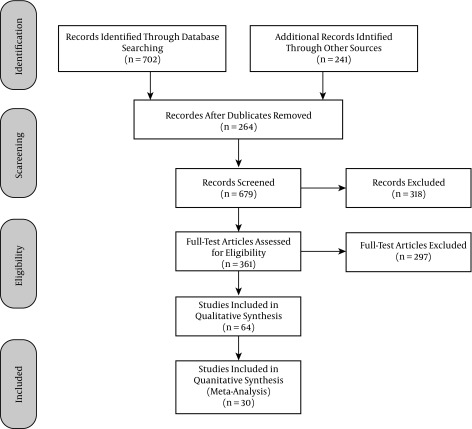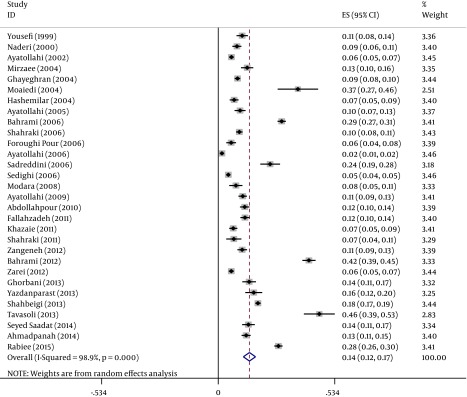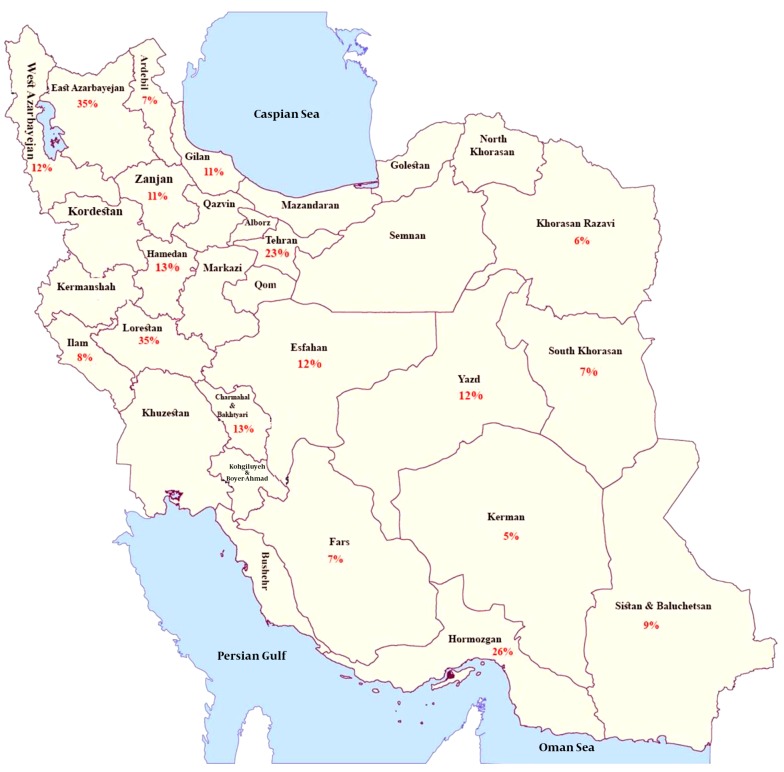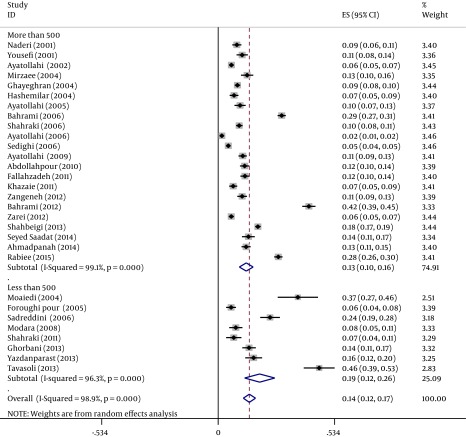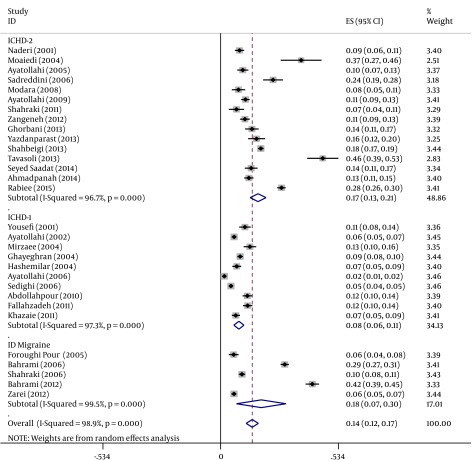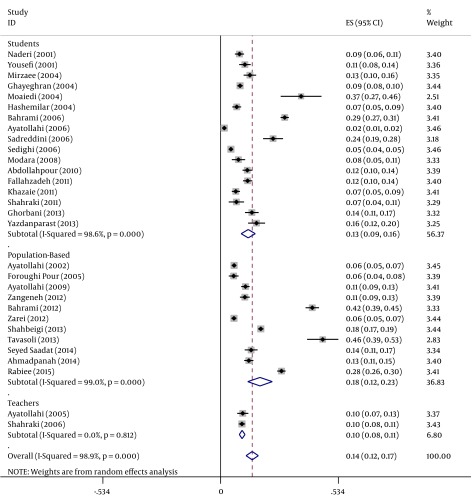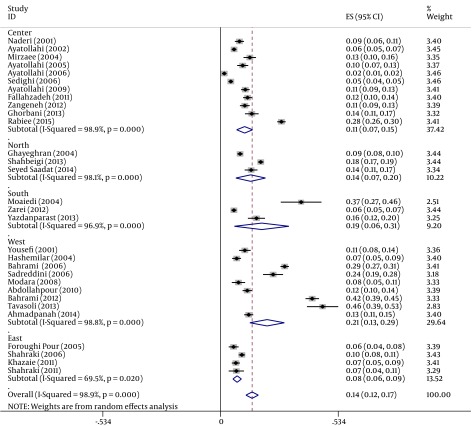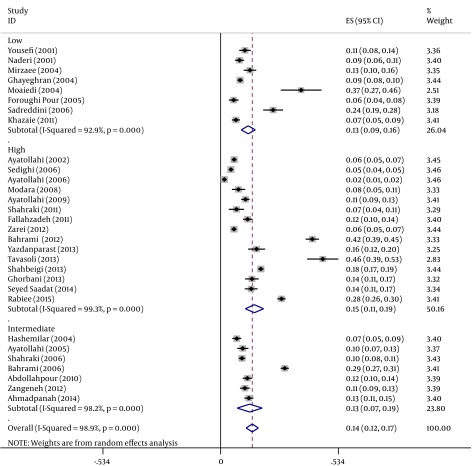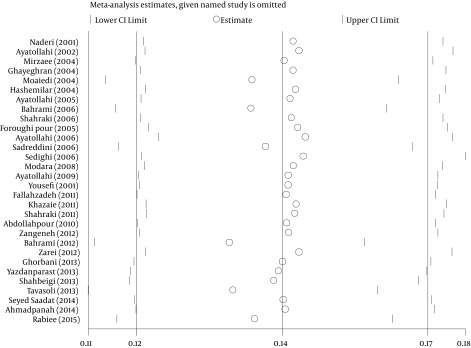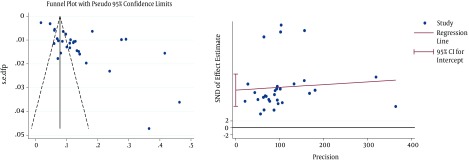Abstract
Context
Migraine is a major dilemma and problem which affects public health and results to reduced quality of life. This study aimed to determine the prevalence of migraine in Iran.
Evidence Acquisition
A systematic search was conducted using Pub Med, Web of Science, Embase, Scopus, Ovid, Google Scholar, as well as Iranian databases including: MagIran, IranMedex and Scientific Information Databank, from 2000 to November, 2015. The Der-Simonian/Laird’s random-effects model, with a 95% confidence interval was employed to estimate the overall pooled prevalence. Heterogeneity was investigated using subgroup analysis based on sample size and time of study.
Results
Thirty studies comprising 33,873 participants met the inclusion criteria for the analysis. The overall prevalence of migraine in Iran was 14% (95% CI, 12% to 17%), respectively. The overall prevalence was (8%; 95% CI 6% to 11%) according to the international classification of headache disorders (ICHD-1), (17%; 95% CI 13% to 21%) according to ICHD-2, and (18%; 95% CI 7% to 30%) according to the other questionnaire for migraine screener (ID Migraine), respectively. Meta-regression demonstrated that the prevalence of migraine increased by year of publication and decreased by sample size.
Conclusions
The prevalence of migraine in Iran, which was estimated as 14%, was similar or even higher than that reported world-wide. Migraine can have impact on the economic productivity of any country; therefore it is necessary to educate people on the early detection and the discovery of an effective treatment of migraine. More thorough review of further studies in this field is recommended.
Keywords: Meta-Analysis, Migraine, Prevalence, Iran
1. Context
Headaches are one of the most common diseases worldwide, and they occur in all age groups, from childhood to old age. Almost everyone experiences headache in life (1). Primary disorders of headache include migraine and tension-headaches (2). Migraine is a chronic neurovascular disorder in the brain. Migraine headache is commonly throbbing and unilateral, and it is associated with photophobia, phonophobia and/or nausea. It could be so severe that it interferes with daily activity (3). People with migraines suffer from pains and attacks which result from the disease. Exposure to sun, stress, anxiety, sleep disorders, multiple trips, eating habits, fatigue, smoking and low levels of economic life are important risk factors associated with migraine (4). Migraine is a major dilemma and problem of public health which leads to reduced quality of life. It also adversely affects the individual, family and social activities (5). People between the ages of 10 to 40, who are considered as part of the economically active workforce in every country, are more prone to migraine attacks (6). Costs arising from the treatment of migraine have great effect on the economy of any country, and due to the disability in the individual caused by the disease; there is decrease in the production and productivity of the active workforces of the society (5, 6). Studies have shown that the prevalence rate of migraines in the world is between 10 and 18% (4). In Western countries, about 12% of the total populations are affected by migraine, with females being three times more prone to this disease than males (7). According to the global of burden disease (GBD) in 2013, migraine is the sixth leading cause of disabilities in the world (8). In recent years, several studies on the prevalence of migraine in different population groups in Iran have been conducted. The present study aimed to determine a general estimate of the prevalence of migraine in Iran and also to assess the general trend of the problem. This study is the first systematic review and meta-analysis of migraine prevalence in Iran. The results of this study may be helpful in enlightening policy makers and authorities regarding the real situation and necessity of adopting effective policies and programs for the purpose of reducing migraine in Iran.
2. Evidence Acquisition
2.1. Data Source
Two authors carried out an independent international databases search, including Pub Med, Web of Science (ISI), Embase, Scopus, Ovid, Google Scholar, while the Iranian databases search included MagIran, IranMedex and Scientific Information Databank (SID). This search was conducted up to November, 2015. Databases were searched using the Mesh terms like ‘‘Prevalence’’, ‘‘Migraine’’ and related terms of studies published in Persian and English languages. References of articles were also checked for any relevant articles. Figure 1 shows the literature search in accordance with the Preferred Reporting Items for Systematic Reviews and Meta-Analyses (PRISMA) (9).
Figure 1. Flowchart of Search and Studies Selection.
2.2. Study Selection
Inclusion criteria were: Studies which reported rate of migraine prevalence among an Iranian-based population, studies which utilized the International system of classification of headache disorder (ICHD) criteria or screening tools for the prevalence of migraine, case-control studies or cohort studies. The exclusion criteria were: unknown sample origins, unclear results and methods, use of case reports and case series design, studies in which the treatment was intended, studies which reported migraine incidence among non-Iranian nationality, meta-analysis, reviews, meeting abstract or editorial comments, and studies having duplicate data.
Articles were independently screened by two authors for relevance, and conflicts were resolved by discussion and a third author.
2.3. Data Extraction
Variables extracted for each study included: First author’s name, publication year, location of studies, age, the gender of the participants, sample size, number of cases, screening method, STROBE quality and diagnostic criteria. Assessment of the quality of the studies was done using strengthening the reporting of observational studies in epidemiology (STROBE) checklist (10). The base checklists of STROBE for the studies were classified in three categories which included high, intermediate and low quality. Seven items from the recommended checklist of STROBE were selected and used for assessing the quality of studies. These items included: present the key elements of the study design, clearly define the outcome of migraine, give the eligibility criteria, explain how the study sample was arrived at, describe the setting, locations, and relevant dates, give sources of data and details of methods of assessment, and describe all statistical methods. The studies were classified as high quality if all items were achieved, as intermediate quality if they did not achieve one criterion, and as low quality if they did not achieve more than one criterion.
2.4. Statistical Analysis
A pooled estimated prevalence of migraine was generated using Der-Simonian and Laird’s random-effects model. The reported effective estimate with 95% confidence interval (CI) variance for the studies was calculated using the Binomial distribution formula. Statistical heterogeneity was assessed among the studies using Chi-square-based Q test and I2 (11).
All statistical significances were at P-values less than 0.05. The sources of heterogeneity were obtained using meta-regression which was analyzed on the prior knowledge of effective factors, such as sample size and publication year. Also, subgroup analysis by sample size, diagnostic criteria, groups, geographical region, and quality of the studies was done to obtain the source of heterogeneity. A sensitivity analysis was performed to determine the effect of each study on the prevalence of migraine by sequentially omitting each data set. Egger’s test and funnel plot was used to assess publication bias (12). All data were analyzed using STATA Ver.12 (Stata Corp, College Station, TX, USA).
3. Results
All databases (English and Persian) were searched from 2000 to 2015 (11 years), using the search keywords. The following search strategy” migraine” OR “headache” AND “prevalence” AND “Iran” were used. Two authors independently assessed the abstract and full-text studies and selected the studies using the inclusion and exclusion criteria. Finally, 30 articles which comprised 33,873 participants were included in this systematic review and meta-analysis study (13-42). The results of literature searches are shown in Figure 1 and Table 1. The pooled prevalence of migraine, using the random-effects model in Iran, was 14% (95% CI 12% to17%), and this is considered as significant (P < 0.05) (Figure 2). The results of Q Cochran test = 2603.99 and I2 = 98.9%, d.f = 29; (P <0.0000) showed the prevalence of migraine as being strongly heterogeneous among 30 studies. The minimum prevalence of migraine was 2% (95% CI 1% to 2%) according to Ayatollahi (2006) (22) in Shiraz, a town province, respectively, and the maximum prevalence of migraine was (46%, 95% CI 39% to 53%) according to Tavasoli (2013) (38) in Tabriz town, respectively. The prevalence of migraine based on provinces in Iran is shown in Figure 3. Meta-regression showed that the prevalence of migraine increased by publication year and decreased by sample size (Table 2 and Figure 4). Based on analysis of the quality of studies which included meta-analysis, according to the STROB check list, it was observed that fifteen studies (50%) were of high quality, eight studies (26.6%) were of intermediate quality, and seven studies (23.4%) were of low quality.
Table 1. Characteristics of All Eligible Studies.
| Author | Year | Cities | Sample Size | Diagnostic Criteria | Participants | Type of Study |
|---|---|---|---|---|---|---|
| Yousefi | 1999 | Zanjan | 554 | ICHD-1 | Students | Cross-sectional |
| Naderi | 2000 | Kerman, Isfahan, Sharekord | 700 | ICHD-2 | Students | Cross-sectional |
| Ayatollahi | 2002 | Shiraz | 1868 | ICHD-1 | Population-based | Cross-sectional |
| Mirzaee | 2004 | Sharehkord | 550 | ICHD-1 | Students | Cross-sectional |
| Ghayeghran | 2004 | Rasht | 1965 | ICHD-1 | Students | Cross-sectional |
| Moaiedi | 2004 | Bandar Abbas | 104 | ICHD-2 | Students | Cross-sectional |
| Hashemilar | 2004 | Ardabil | 631 | ICHD-1 | Students | Cross-sectional |
| Ayatollahi | 2005 | Shiraz | 538 | ICHD-2 | Teachers | Cross-sectional |
| Bahrami | 2006 | Khoramabad | 2213 | Other questionnaire | Students | Cross-sectional |
| Shahraki | 2006 | Zahedan | 1539 | Other questionnaire | Teachers | Cross-sectional |
| Foroughi pour | 2006 | Mashhad | 423 | Other questionnaire | Population-based | Cross-sectional |
| Ayatollahi | 2006 | Shiraz | 2226 | ICHD-1 | Students | Cross-sectional |
| Sadreddini | 2006 | Tabriz | 340 | ICHD-2 | Students | Cross-sectional |
| Sedighi | 2006 | Kerman | 4521 | ICHD-1 | Students | Cross-sectional |
| Modara | 2008 | Ilam | 309 | ICHD-2 | Students | Cross-sectional |
| Ayatollahi | 2009 | Shiraz | 1023 | ICHD-2 | Population-based | Cross-sectional |
| Fallahzadeh | 2011 | Yazd | 930 | ICHD-1 | Students | Cross-sectional |
| Khazaie | 2011 | Birjand | 723 | ICHD-1 | Students | Cross-sectional |
| Shahraki | 2011 | Zahedan | 210 | ICHD-2 | Students | Cross-sectional |
| Zangeneh | 2012 | Isfahan | 764 | ICHD-2 | Population-based | Cross-sectional |
| Bahrami | 2012 | Khoramabad | 1000 | Other questionnaire | Population-based | Cross-sectional |
| Zarei | 2012 | Jahrom | 1593 | Other questionnaire | Population-based | Cross-sectional |
| Ghorbani | 2013 | Isfahan | 480 | ICHD-2 | Students | Cross-sectional |
| Yazdanparast | 2013 | BandarAbbas | 350 | ICHD-2 | Students | Cross-sectional |
| Shahbeigi | 2013 | Tehran | 3655 | ICHD-2 | Population-based | Cross-sectional |
| Tavasoli | 2013 | Tabriz | 190 | ICHD-2 | Population-based | Cross-sectional |
| Abdollahpour | 2010 | Boukan | 857 | ICHD-1 | Students | Cross-sectional |
| Seyed Saadat | 2014 | Rasht | 541 | ICHD-2 | Population-based | Cross-sectional |
| Ahmadpanah | 2014 | Hamadan | 1000 | ICHD-2 | Population-based | Cross-sectional |
| Rabiee | 2015 | Tehran | 2076 | ICHD-2 | Population-based | Cross-sectional |
Figure 2. Forest Plot of Prevalence of Migraine in Iran Based on Diagnostic Criteria.
Figure 3. Graphic Representation of Overall Distribution of Migraine in the Provinces in Iran.
Table 2. Meta-Regression Analysis of Prevalence of Migraine in Iran.
| Coefficient | Standard Error | T | P | Confidence Interval 95% | ||
|---|---|---|---|---|---|---|
| Lower | Upper | |||||
| Publication year | 0.0074331 | 0.0045972 | 1.62 | 0.118 | -0.0019996 | 0.0168659 |
| Sample size | -0.0000157 | 0.0000191 | -0.82 | 0.419 | -0.0000549 | 0.0000235 |
| Cons | -14.76564 | 9.23323 | -1.60 | 0.121 | -33.71066 | 4.179387 |
Figure 4. Association Between Prevalence by Publication of Year and Sample Size.
The results of the subgroup analysis showed the prevalence of migraine in Iran based sample size, diagnostic criteria, groups and geographical region, was performed.
The pooled prevalence was based on sample size as shown in Figure 5. The pooled prevalence was based on diagnostic criteria as shown in Figure 6. The pooled prevalence was based on groups of participants as shown in Figure 7. The pooled prevalence was based on geographical region as shown in Figure 8. The pooled prevalence was based on quality of studies as shown in Figure 9.
Figure 5. The Pooled Prevalence of Migraine in Iran Was Based on Sample Size.
Figure 6. The Pooled Prevalence of Migraine in Iran Was Based on Diagnostic Criteria.
Figure 7. The Pooled Prevalence of Migraine in Iran Was Based on Groups of Participants.
Figure 8. The Pooled Prevalence of Migraine in Iran Was Based on Geographical Region.
Figure 9. The Pooled Prevalence of Migraine in Iran Was Based on Quality of Studies.
For robustness of result, sensitivity analysis was performed by eliminating each study. There was no significant change in the overall prevalence (Figure 10). Figure 11 shows the analyses of the publication bias of studies in review, using Egger’s test and funnel plot. The results showed that there existed publication bias among the studies (P = 0.000).
Figure 10. The Pooled Prevalence Sensivity Analysis of Migriane in Iran.
Figure 11. Funnel Plot and Egger Test to Assess Publication Bias.
4. Discussion
The prevalence rate of Migraine obtained for an Iranian population was obtained as 14%. This rate is higher than that reported by Lipton et al. in US (43), Radtke and Hannelore in Germany (44), and Ertas et al. in Turkey (45), but lower than that reported by Manandhar et al. in Nepal (46) and Rao et al. in India (47). The articles obtained from the subgroup were analyzed to evaluate the ratio of prevalence rate of migraine in the studied groups. In the current study, the prevalence rate of migraine among medical students was higher than that obtained by Ojini in Nigeria (48), and lower than that obtained by Bindu Menon and Kinnera in India (49), and Kurt and Kaplan (50). The difference in the prevalence rate of migraine in medical students obtained from various studies can be justified due to some reasons like diverse work methods or differences in the questionnaires used in studies. However, the greater number of females in the studies in comparison to the males could also be another reason for the prevalence of migraine in the students. Some stressful periods like midterm or final exams could also be responsible for the higher prevalence rate of migraine in the students. Racial and economic differences, climatic conditions, feeding habits and social situations may also be some factors which influenced the prevalence rate of migraine in the students (51). In different studies, the prevalence rate of migraine was investigated in medical students and according to the results; the students were more likely to have migraines than any other non-medical students due to the environmentally and educationally stressful conditions (52, 53). Migraine in primary and high school students is often associated with complaints of headaches, and in many cases this issue prevents the students from attending schools, resulting to disability in daily activities. Iran is of a young population, and the identification of individuals who suffer from migraines can lead to the discovery of treatment which can help to make the patients an economically active workforce and more productive in the society. At the secondary and high schools ages, daily stresses faced by the students can lead to an increase in the risk of migraine. Stressful events for students commences from the beginning of school, and the expectations of parents from the students to attain the peak of academic achievements is another reason which can cause an increased incidence of migraine (54, 55). The interpretation of the prevalence with respect to different geographical areas in Iran showed high prevalence rate of migraine in the South and West (40%). The southern regions in Iran are geographically tropical and the air temperature is very high. Daily activities and work-related stresses in hot and harsh conditions could be the reason for the increased prevalence of migraine in these areas. The Western regions in Iran are associated with cold weather, and cities in these areas often have large populations and lower economic levels. These conditions prevent people from meeting their financial needs. Hard physical activities and individual stresses could also be justifiable reasons for the prevalence of migraine in these areas. A number of studies have noted the relationship between vitamin D levels and the incidence of chronic pain (56). Some anecdotal evidences indicated that vitamin D may have a role in the incidence of headaches (57). The prevalence of migraine is worldwide and in different geographic areas (3). Many factors could be responsible for the differences in the ratio of prevalence of migraine in several countries. Some of these factors include cultures and also environmental and genetic conditions (58). The results of this study suggest that migraine is indeed influenced by climate, economic index and cultural factors. It seems that job conditions can either increase or decrease the prevalence of migraine in patients. Of course, this issue requires additional study. The results of the meta-regression indicated that there existed no significant relationship between the prevalence of migraine and the year of publication and sample size of the studies; however, Figure 4 shows a decreasing trend for the prevalence of migraine in Iran; although this was not found to be significant. These decreasing trends in countries might have resulted from factors like increased levels of quality of life and the promotion of educational programs and diagnostic methods for migraine, to mention a few. Notwithstanding, there may be unknown factors or changes in the known contributory factors over time.
A comparison of the prevalence of migraine in different regions of Iran indicated that it is widespread in the western (21 %), southern (19 %), central and north (11 %), and eastern (8 %) regions. It has been suggested that several social, climatic conditions, economic, and cultural factors may have effect on the prevalence of migraine. The differences in the prevalence of migraine between the various regions in Iran are therefore not surprising, given that the Iranian population exhibits cultural diversity and different economic index. It seems that the results of this study indicate that the living conditions can also have a great impact on the higher prevalence of migraine in the different groups of the society, such students. This agrees with the previous findings that migraine prevalence increases rapidly in studies regarding age.
One of the major advantages of this study is the huge sample size which is a valuable study in the field of evaluating the prevalence rate of migraine in Iran. Over the past years, in Iran, the prevalence of migraine in a population based on various studies in different provinces has been evaluated using a variety of methods performed by questionnaires and face to face interviews. The incongruity among 30 studies was analyzed. Some limitations of the study are: in the present study, the methods of conducting the 30 studies entered into the analysis contained large variety, and the significant heterogeneity was identified among studies. This issue had effect on the accuracy of the results. Lack of consistency in the diagnostic criteria in some studies regarding the diagnosis of migraine was one of the important reasons for heterogeneity among studies. Also, in some provinces of Iran, there existed no previous studies on the prevalence of migraine. There was no appropriate data according to gender and age in some studies. Under such conditions, the results of this study should be interpreted with caution.
In conclusion, migraine in Iran has an estimated prevalence of 14%. The study showed that the prevalence of migraine is high in Iran. Considering the impacts of migraine on economic productivity of any country, it seems necessary to train people for the early detection and obtaining of effective treatment of migraine. However, more studies are required to assess the prevalence of migraine in the population of Iran.
Acknowledgments
The authors are grateful to the reviewers for their constructive comments, which improved the manuscript.
Footnotes
Authors’ Contribution:Meysam Behzadifar, Hamid Ravaghi, Roghayeh Mohammadibakhsh, Masood Taheri Mirghaed, Morteza Salemi, Rahim Sohrabi, Zeynab Farhadi, Najmeh Khodadadi, Saeideh Alidoost, Razieh Sepehrian: data Collection and study design; Hamid Ravaghi, Masoud Behzadifar: final revision and grammar editing; Masoud Behzadifar: biostatical analysis.
References
- 1.Steiner TJ, Stovner LJ, Birbeck GL. Migraine: the seventh disabler. J Headache Pain. 2013;14:1. doi: 10.1186/1129-2377-14-1. [DOI] [PMC free article] [PubMed] [Google Scholar]
- 2.Jensen R, Stovner LJ. Epidemiology and comorbidity of headache. Lancet Neurol. 2008;7(4):354–61. doi: 10.1016/S1474-4422(08)70062-0. [DOI] [PubMed] [Google Scholar]
- 3.Stovner L, Hagen K, Jensen R, Katsarava Z, Lipton R, Scher A, et al. The global burden of headache: a documentation of headache prevalence and disability worldwide. Cephalalgia. 2007;27(3):193–210. doi: 10.1111/j.1468-2982.2007.01288.x. [DOI] [PubMed] [Google Scholar]
- 4.Rasmussen BK. Epidemiology of headache. Cephalalgia. 2001;21(7):774–7. doi: 10.1177/033310240102100708. [DOI] [PubMed] [Google Scholar]
- 5.Lanteri-Minet M, Duru G, Mudge M, Cottrell S. Quality of life impairment, disability and economic burden associated with chronic daily headache, focusing on chronic migraine with or without medication overuse: a systematic review. Cephalalgia. 2011;31(7):837–50. doi: 10.1177/0333102411398400. [DOI] [PubMed] [Google Scholar]
- 6.Wahab KW, Ugheoke AJ. Migraine: prevalence and associated disability among Nigerian undergraduates. Can J Neurol Sci. 2009;36(2):216–21. doi: 10.1017/s0317167100006570. [DOI] [PubMed] [Google Scholar]
- 7.Lima AM, Sapienza GB, Giraud Vde O, Fragoso YD. Odors as triggering and worsening factors for migraine in men. Arq Neuropsiquiatr. 2011;69(2B):324–7. doi: 10.1590/s0004-282x2011000300011. [DOI] [PubMed] [Google Scholar]
- 8.Global Burden of Disease Study C. Global, regional, and national incidence, prevalence, and years lived with disability for 301 acute and chronic diseases and injuries in 188 countries, 1990-2013: a systematic analysis for the Global Burden of Disease Study 2013. Lancet. 2015;386(9995):743–800. doi: 10.1016/S0140-6736(15)60692-4. [DOI] [PMC free article] [PubMed] [Google Scholar]
- 9.Liberati A, Altman DG, Tetzlaff J, Mulrow C, Gotzsche PC, Ioannidis JP, et al. The PRISMA statement for reporting systematic reviews and meta-analyses of studies that evaluate healthcare interventions: explanation and elaboration. BMJ. 2009;339:b2700. doi: 10.1136/bmj.b2700. [DOI] [PMC free article] [PubMed] [Google Scholar]
- 10.von Elm E, Altman DG, Egger M, Pocock SJ, Gotzsche PC, Vandenbroucke JP, et al. The Strengthening the Reporting of Observational Studies in Epidemiology (STROBE) statement: guidelines for reporting observational studies. Bull World Health Organ. 2007;85(11):867–72. doi: 10.2471/BLT.07.045120. [DOI] [PMC free article] [PubMed] [Google Scholar]
- 11.Higgins JP, Thompson SG, Deeks JJ, Altman DG. Measuring inconsistency in meta-analyses. BMJ. 2003;327(7414):557–60. doi: 10.1136/bmj.327.7414.557. [DOI] [PMC free article] [PubMed] [Google Scholar]
- 12.Egger M, Davey Smith G, Schneider M, Minder C. Bias in meta-analysis detected by a simple, graphical test. BMJ. 1997;315(7109):629–34. doi: 10.1136/bmj.315.7109.629. [DOI] [PMC free article] [PubMed] [Google Scholar]
- 13.Naderi T, Hamzehie-Moghadam A, Bahrampour A. Prevalence of migraine and its related factors in female students with premenstural syndrom [in Persian]. Scie J Kurdistan Uni Med Sci. 2000;5(1):18–22. [Google Scholar]
- 14.Yousefi M. Prevalence of migraine in medical students and doctors, Zanjan University of medical sciences. Zanjan Uni Med Sci. 1999;8(30):18–22. [Google Scholar]
- 15.Ayatollahi SM, Moradi F, Ayatollahi SA. Prevalences of migraine and tension-type headache in adolescent girls of Shiraz (southern Iran). Headache. 2002;42(4):287–90. doi: 10.1046/j.1526-4610.2002.02082.x. [DOI] [PubMed] [Google Scholar]
- 16.Ghayeghran AF. Survey on Prevalence of Migraine in Highschool Students of Rasht- City. J Guilan Uni Med Sci. 2004;13(50):22–6. [Google Scholar]
- 17.Hashemilar M, Aminisani N, Savadi Oskoui D, Yosefian M. The Prevalence of Migraine Among Student of Ardabil University of Medical Sciences, 2003. J Ardebbil Uni Med Sci. 2004;4(1):64–9. [Google Scholar]
- 18.Mirzaee MG. A review of cammon migraine in girls high school and related fall in education in Shahrekord region. J Shahrekord Univ Med Sci. 2004;5(4):55–62. [Google Scholar]
- 19.Moaiedi AR. Causes of headache in patients referring to Bandar Abbas pediatric hospital. Hormozgan Med J. 2004;8(2):73–6. [Google Scholar]
- 20.Ayatollahi SM. An Epidemiologic Model for Risk Factors of Migraine and Tension type Headaches among Primary Schools Teachers of Shiraz, 2003. J Kerman Uni Med Sci. 2005;12(2):85–92. [Google Scholar]
- 21.Foroughipour MR, Raziei MB, Faraji M, Rezaei Talab F, Saberi S. Evaluation of the causes of headache in patients referred to neurological clinic of Ghaem Hospital. Iran J Otorhinolaryngol. 2006;17(39):64–9. [Google Scholar]
- 22.Ayatollahi SM, Khosravi A. Prevalence of migraine and tension-type headache in primary-school children in Shiraz. East Mediterr Health J. 2006;12(6):809–17. [PubMed] [Google Scholar]
- 23.Bahrami P. Incidence of Migraine in high school students in Khorramabad. Yafteh. 2006;7(1):55–60. [Google Scholar]
- 24.Sadreddini SA, Talebi M. Assessment of Prevalence and Type of Headache in Medical Students. J Tabriz Uni Med Sci Health Serv. 2006;28:73–9. [Google Scholar]
- 25.Sedighi B, Ghaderi-Sohi S, Emami S. Evaluation of self-medication prevalence, diagnosis and prescription in migraine in Kerman, Iran. Saudi Med J. 2006;27(3):377–80. [PubMed] [Google Scholar]
- 26.Shahraki MR, Moghtaderi A, Mirshekari H. The study of prevalence of migraine among teachers at Zahedan, Iran. J Zahedan Res Med Sci. 2006;8(2):137–42. [Google Scholar]
- 27.Modara FR, Rostamkhani M. Prevalence of tension and migraine headachesamong the students of Ilam Medical University. J Ilam Uni Med Sci. 2008;15(4):13–21. [Google Scholar]
- 28.Ayatollahi SM, Haghighi AB. Epidemiologic and Clinical Characteristics of Migraine and Tension-Type Headaches among Hospitals Staffs of Shiraz (Iran). Acta Med Iran. 2009;47(2):115–20. [Google Scholar]
- 29.Abdollahpour I, Salimi Y, Jabbedari B, Hajji M, Jarjaran Shoshtari Z. Prevalence of Migraine and its Triggers in High School Student in Boukan. Urumia Med J. 2013;23(6):661–9. [Google Scholar]
- 30.Fallahzadeh H, Alihaydari M. Prevalence of migraine and tension-type headache among school children in Yazd, Iran. J Pediatr Neurosci. 2011;6(2):106–9. doi: 10.4103/1817-1745.92818. [DOI] [PMC free article] [PubMed] [Google Scholar]
- 31.Khazaie T, Dehghani Firoozabadi M, Sharifzadeh R. Prevalence of migraine and its relationship to educational performance in adolescents of Brijand city (2010). J Birjand Uni Med Sci. 2011;18(2):94–101. [Google Scholar]
- 32.Shahrakai MR, Mirshekari H, Ghanbari AT, Shahraki AR, Shahraki E. Prevalence of Migraine Among Medical Students in Zahedan Faculty of Medicine (Southeast of Iran). Basic Clin Neurosci. 2011;2(2):20–5. [Google Scholar]
- 33.Bahrami P, Zebardast H, Zibaei M, Mohammadzadeh M, Zabandan N. Prevalence and characteristics of headache in Khoramabad, Iran. Pain Physician. 2012;15(4):327–32. [PubMed] [Google Scholar]
- 34.Zangeneh FA, Najafi MR, Norouzi R. Epidemiologic and Clinical Characteristics of Migraine Headaches:A Descriptive Study in Isfahan, Iran. J Isfahan Med School. 2012;30(187):1–7. [Google Scholar]
- 35.Zarei S, Bigizadeh S, Pourahmadi M, Ghobadifar MA. Chronic Pain and Its Determinants: A Population-based Study in Southern Iran. Korean J Pain. 2012;25(4):245–53. doi: 10.3344/kjp.2012.25.4.245. [DOI] [PMC free article] [PubMed] [Google Scholar]
- 36.Ghorbani A, Abtahi SM, Fereidan-Esfahani M, Abtahi SH, Shemshaki H, Akbari M, et al. Prevalence and clinical characteristics of headache among medical students, Isfahan, Iran. J Res Med Sci. 2013;18(Suppl 1):24–7. [PMC free article] [PubMed] [Google Scholar]
- 37.Shahbeigi S, Fereshtehnejad SM, Mohammadi N, Golmakani MM, Tadayyon S, Jalilzadeh G, et al. Epidemiology of headaches in Tehran urban area: a population-based cross-sectional study in district 8, year 2010. Neurol Sci. 2013;34(7):1157–66. doi: 10.1007/s10072-012-1200-0. [DOI] [PubMed] [Google Scholar]
- 38.Tavasoli A, Aghamohammadpoor M, Taghibeigi M. Migraine and tension-type headache in children and adolescents presenting to neurology clinics. Iran J Pediatr. 2013;23(5):536–40. [PMC free article] [PubMed] [Google Scholar]
- 39.Yazdanparast M, Abrishamizadeh AA, Mahboobi H, Omrani A, Ghasemi M, Ghorashi M, et al. Prevalence of and Factors Associated with Migraine in Medical Students at BandarAbbas, Southern Iran, in 2012. Electron Physician. 2013;5(3):679–84. doi: 10.14661/2013.679-684. [DOI] [PMC free article] [PubMed] [Google Scholar]
- 40.Ahmadpanah M, Ghaderzadeh P. Investigation of prevalence and clinical characteristics of migraine patients referred to the neurology department of Sina Hospital, 2010. Pajouhan Scien J. 2014;12(4):1–6. [Google Scholar]
- 41.Seyed Saadat SM, Hosseininezhad M, Bakhshayesh B, Hoseini M, Naghipour M. Epidemiology and clinical characteristics of chronic daily headache in a clinic-based cohort of Iranian population. Neurol Sci. 2014;35(4):565–70. doi: 10.1007/s10072-013-1550-2. [DOI] [PubMed] [Google Scholar]
- 42.Rabiee B, Zeinoddini A, Kordi R, Yunesian M, Mohammadinejad P, Mansournia MA. The Epidemiology of Migraine Headache in General Population of Tehran, Iran. Neuroepidemiology. 2016;46(1):9–13. doi: 10.1159/000441146. [DOI] [PubMed] [Google Scholar]
- 43.Lipton RB, Bigal ME, Diamond M, Freitag F, Reed ML, Stewart WF, et al. Migraine prevalence, disease burden, and the need for preventive therapy. Neurology. 2007;68(5):343–9. doi: 10.1212/01.wnl.0000252808.97649.21. [DOI] [PubMed] [Google Scholar]
- 44.Radtke A, Neuhauser H. Prevalence and burden of headache and migraine in Germany. Headache. 2009;49(1):79–89. doi: 10.1111/j.1526-4610.2008.01263.x. [DOI] [PubMed] [Google Scholar]
- 45.Ertas M, Baykan B, Orhan EK, Zarifoglu M, Karli N, Saip S, et al. One-year prevalence and the impact of migraine and tension-type headache in Turkey: a nationwide home-based study in adults. J Headache Pain. 2012;13(2):147–57. doi: 10.1007/s10194-011-0414-5. [DOI] [PMC free article] [PubMed] [Google Scholar]
- 46.Manandhar K, Risal A, Steiner TJ, Holen A, Linde M. The prevalence of primary headache disorders in Nepal: a nationwide population-based study. J Headache Pain. 2015;16:95. doi: 10.1186/s10194-015-0580-y. [DOI] [PMC free article] [PubMed] [Google Scholar]
- 47.Rao GN, Kulkarni GB, Gururaj G, Rajesh K, Subbakrishna DK, Steiner TJ, et al. The burden of headache disorders in India: methodology and questionnaire validation for a community-based survey in Karnataka State. J Headache Pain. 2012;13(7):543–50. doi: 10.1007/s10194-012-0474-1. [DOI] [PMC free article] [PubMed] [Google Scholar]
- 48.Ojini FI, Okubadejo NU, Danesi MA. Prevalence and clinical characteristics of headache in medical students of the University of Lagos, Nigeria. Cephalalgia. 2009;29(4):472–7. doi: 10.1111/j.1468-2982.2008.01766.x. [DOI] [PubMed] [Google Scholar]
- 49.Menon B, Kinnera N. Prevalence and characteristics of migraine in medical students and its impact on their daily activities. Ann Indian Acad Neurol. 2013;16(2):221–5. doi: 10.4103/0972-2327.112472. [DOI] [PMC free article] [PubMed] [Google Scholar]
- 50.Kurt S, Kaplan Y. Epidemiological and clinical characteristics of headache in university students. Clin Neurol Neurosurg. 2008;110(1):46–50. doi: 10.1016/j.clineuro.2007.09.001. [DOI] [PubMed] [Google Scholar]
- 51.Nandha R, Chhabra MK. Prevalence and clinical characteristics of headache in dental students of a tertiary care teaching dental hospital in Northern India. Int J Basic Clin Pharmacol. 2013;2(1):51–5. doi: 10.5455/2319-2003.ijbcp20130110. [DOI] [Google Scholar]
- 52.Ferri-de-Barros JE, Alencar MJ, Berchielli LF, Castelhano Junior LC. Headache among medical and psychology students. Arq Neuropsiquiatr. 2011;69(3):502–8. doi: 10.1590/s0004-282x2011000400018. [DOI] [PubMed] [Google Scholar]
- 53.Ezeala-Adikaibe AB, Stella EO, Ikenna O, Ifeoma U. Frequency and pattern of headache among medical students at Enugu, South East Nigeria. Niger J Med. 2012;21(2):205–8. [PubMed] [Google Scholar]
- 54.Karli N, Akis N, Zarifoglu M, Akgoz S, Irgil E, Ayvacioglu U, et al. Headache prevalence in adolescents aged 12 to 17: a student-based epidemiological study in Bursa. Headache. 2006;46(4):649–55. doi: 10.1111/j.1526-4610.2006.00362.x. [DOI] [PubMed] [Google Scholar]
- 55.Laurell K, Larsson B, Mattsson P, Eeg-Olofsson O. A 3-year follow-up of headache diagnoses and symptoms in Swedish schoolchildren. Cephalalgia. 2006;26(7):809–15. doi: 10.1111/j.1468-2982.2006.01113.x. [DOI] [PubMed] [Google Scholar]
- 56.Straube S, Andrew Moore R, Derry S, McQuay HJ. Vitamin D and chronic pain. Pain. 2009;141(1-2):10–3. doi: 10.1016/j.pain.2008.11.010. [DOI] [PubMed] [Google Scholar]
- 57.Prakash S, Shah ND. Chronic tension-type headache with vitamin D deficiency: casual or causal association? Headache. 2009;49(8):1214–22. doi: 10.1111/j.1526-4610.2009.01483.x. [DOI] [PubMed] [Google Scholar]
- 58.Prakash S, Mehta NC, Dabhi AS, Lakhani O, Khilari M, Shah ND. The prevalence of headache may be related with the latitude: a possible role of Vitamin D insufficiency? J Headache Pain. 2010;11(4):301–7. doi: 10.1007/s10194-010-0223-2. [DOI] [PMC free article] [PubMed] [Google Scholar]



